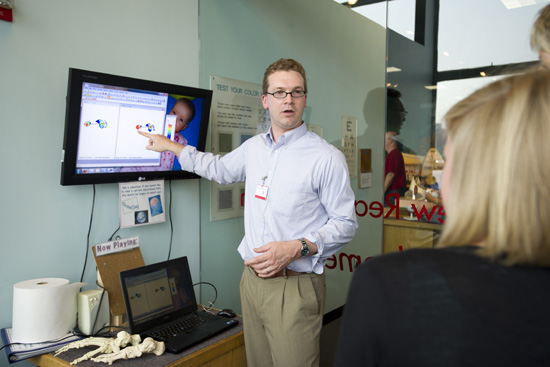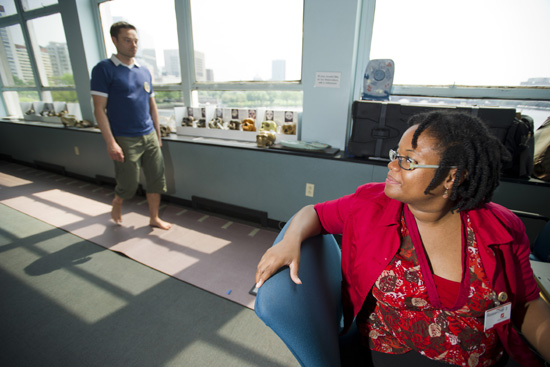Arch Support
BU profs seek to unlock mysteries of the human foot

Jeremy DeSilva, a College of Arts & Sciences assistant professor of anthropology, calculates the height of a study participant’s foot arch. Photo by Cydney Scott
Last winter Jeremy DeSilva and Simone Gill met over coffee to talk shop about how the human foot works. DeSilva is interested in prehistoric feet, how their anatomy changed when our ancestors gave up tree climbing for walking upright. Gill studies modern feet, specifically how obesity might affect them.
Given their different interests, neither DeSilva, a College of Arts & Sciences assistant professor of anthropology, nor Gill, a Sargent College assistant professor of occupational therapy, expected more than a lively conversation. But before draining their cups, they brainstormed a brand-new research project designed to answer a fundamental question: how does the shape of a person’s arch affect the way he or she walks? The answer could help the anthropologist understand how early humans walked, and the occupational therapist could use the knowledge to improve health care.
We are all born with flat feet lined with a thick fat pad. During childhood, the pad thins and tendons and ligaments essentially cinch the foot’s arch into place. But there is a huge range in not only the height of an arch, but also the shape, and how that shape relates to people’s gait is little known, DeSilva says. That information would be a required baseline for each professor’s research.
For Gill, it could be the first step in an investigation of why obesity makes people more prone to injury. “My goal is to understand how they move differently so we can alleviate their safety risks,” she says.
Because arches are all soft tissue, they leave no trace in the fossil record. So DeSilva has only bones to work with. “To interpret these bones we need a model,” he says. “We need a good understanding of how a similar creature today moves.”

The two launched their study with a $15,000 grant from Clarks Shoes and with help from neurobiology major Archana Narain (CAS’12) and anthropology major Sara Keimig (CAS’12). Keimig came up with a new and more exact way to analyze people’s arches for the study, DeSilva says.
DeSilva and Gill eschewed the controlled climes of a lab for a more public setting, one that offered a wide range of potential participants. Every Wednesday afternoon this past summer they commandeered the Living Laboratory on the second floor of the Museum of Science.
On a July afternoon, Elizabeth Schweiger (SAR’13), a graduate student in occupational therapy, unfurled a mocha-colored mat that ran the length of the room. Sensors in the mat measure the speed with which people walk, as well as the length of their stride. Next Schweiger plunked a smaller gray mat on the floor to measure the pressure with which people step. Museum visitors began to crowd around the door, eager to lend their footsteps to science.
Keimig and Schweiger recorded the volunteers’ weight and height, used to come up with their body mass index, as well as their waist measurements and how many inches from their hips to their ankles.
On this summer afternoon, an 11-year-old boy was the first to stride the length of the long mat. As he did, images of his footsteps trailed across Gill’s computer screen. The program quickly measured the length of his stride, his walking speed, and any rotation of his feet. He does turn his feet in a little, Gill told him.
On DeSilva’s screen a print of the boy’s left foot lit up in reds, blues, and greens. The colors showed where his foot contacted the ground and with what force. His heel, the ball of his foot, and his big toe lit up in red, pinpointing where he landed the hardest. A swath of blue from the inside of his heel to the ball of his foot showed that his entire foot contacted the floor. His last two toes didn’t even register, indicating he wasn’t pressing down with them.
The public-setting strategy paid off. By summer’s end, 275 people ranging in age from 3 to 80 had walked down the mats. DeSilva and Gill will return to the Museum of Science next summer to conclude their research. Before the study ends, the two researchers hope to have examined the arches of 1,000 people. So far, they say, they’ve had at least one big surprise: their calculations show that, contrary to what they expected, flat-footed people have wider stances and longer steps than people with high arches.
Thus, step by step, DeSilva and Gill hope to solve the mystery of the arch.
Amy Sutherland can be reached at alks@bu.edu.edu.
Comments & Discussion
Boston University moderates comments to facilitate an informed, substantive, civil conversation. Abusive, profane, self-promotional, misleading, incoherent or off-topic comments will be rejected. Moderators are staffed during regular business hours (EST) and can only accept comments written in English. Statistics or facts must include a citation or a link to the citation.